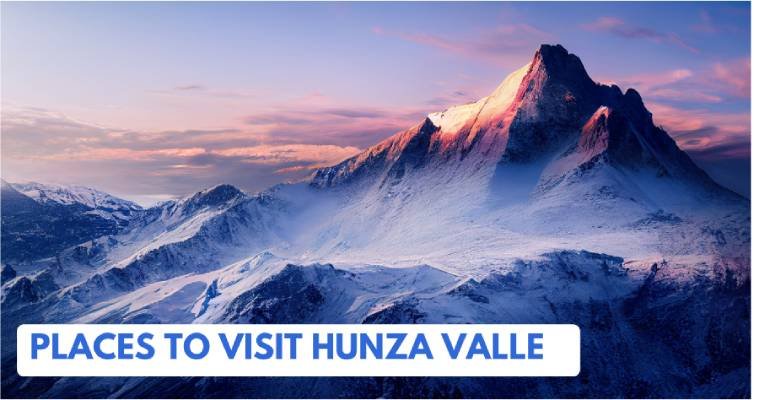Hunza Valley, located in Gilgit-Baltistan, is a breathtaking destination renowned for its stunning landscapes and rich cultural heritage. As one of the top tourist spots in Pakistan, it offers a unique blend of historical sites, adventure, and natural beauty. This guide will take you through the best places to visit in Hunza Valley, from iconic landmarks to hidden gems that showcase the valley’s charm.
Table of Contents
ToggleOverview
Hunza Valley, settled in the Gilgit-Baltistan district of northern Pakistan, is a stunning destination that captivates visitors with its incredible scenery and rich cultural legacy. Situated along the famous Karakoram Highway, Hunza is easily accessible, making it a popular stop for travelers exploring the northern regions of Pakistan. The valley’s historical significance is deeply rooted in its position as a crossroads of ancient trade routes, blending various cultures and traditions over centuries. Hunza is home to ancient forts like Baltit and Altit, which stand as symbols of its rich past and resilient people. The valley is also famous for its warm hospitality and vibrant local traditions, making it a must-visit for those seeking a unique cultural experience. The best time to visit Hunza Valley is between April and October, when the weather is pleasant, and the valley is in full bloom. During these months, visitors can witness the cherry blossom season, lush green terraces, and the majestic peaks of Rakaposhi and Ultar Sar. Whether you’re seeking adventure, serenity, or a glimpse into history, Hunza Valley offers an unforgettable experience that stays with you long after your journey ends.
Must Places to Visit in Hunza Valley
Karimabad:
Karimabad is a picturesque town in the Hunza Valley, known for its historical significance and stunning natural beauty. It is the primary settlement of the Hunza region and serves as a gateway to the valley’s rich cultural heritage. Local markets in Karimabad offer a vibrant mix of traditional crafts, local food, and souvenirs, providing visitors with an authentic taste of Hunza’s culture. Attractions in Karimabad include charming streets and traditional architecture that reflect the region’s history.
Baltit Fort:
Baltit Fort is an ancient fortress located in Karimabad, famous for its rich history and unique architecture. This historical site, built over 700 years ago, is a significant UNESCO heritage site due to its excellent preservation and cultural importance. The fort showcases traditional Hunza craftsmanship and offers a glimpse into the region’s past, making it a must-visit for history enthusiasts and architecture lovers.
Altit Fort:
Altit Fort, situated in the upper Hunza region, is one of the oldest forts in the area with a history spanning over 1,000 years. It serves as a cultural hub, hosting exhibitions and activities that celebrate Hunza’s heritage. The fort’s architecture reflects traditional local design, and its location offers stunning views of the surrounding landscapes. Visitors can explore the fort’s rich history and enjoy the cultural displays that highlight Hunza’s vibrant traditions.
Attabad Lake:
Attabad Lake, located in the Hunza Valley of Gilgit-Baltistan, Pakistan, is a stunning natural wonder that was formed in January 2010 as a result of a massive landslide that blocked the flow of the Hunza River. The lake, also known as Gojal Lake, stretches over 21 kilometers and has become one of the most picturesque destinations in the region.
What makes Attabad Lake truly remarkable is its striking turquoise waters, which contrast beautifully with the rugged, snow-capped peaks surrounding it. The lake has transformed from a tragic event into a major tourist attraction, offering various recreational activities such as boating, fishing, and jet skiing. The serene environment and breathtaking scenery provide visitors with a sense of tranquility and adventure.
Attabad Lake has also had a significant impact on the local communities, creating new opportunities for tourism and economic growth while preserving the natural beauty of the region. Whether you’re seeking adventure or simply wish to soak in the natural beauty, Attabad Lake is a must-visit destination in Hunza Valley.
The Passu Cones are a group of jagged peaks located near the Passu village in Hunza Valley. These iconic mountains are celebrated for their breathtaking beauty and are a favorite among photographers and nature enthusiasts. The Cones provide excellent trekking opportunities, allowing adventurers to explore the rugged terrain and enjoy panoramic views of the surrounding landscapes. The unique shape of these peaks makes them a prominent feature of Hunza’s natural scenery.
Eagle’s Nest:
Eagle’s Nest is a popular viewpoint in Hunza Valley that offers panoramic views of the surrounding mountains and valleys. It is an ideal location for viewing both sunrise and sunset, providing breathtaking vistas that captivate visitors. The viewpoint is situated at a high elevation, providing an unobstructed view of the majestic peaks of the Karakoram range, including Rakaposhi and Diran.
Hussaini Suspension Bridge:
The Hussaini Suspension Bridge is famous for its thrilling and adventurous experience. It is one of the most dangerous suspension bridges in the world, hanging precariously over the Hunza River. The bridge’s historical significance stems from its role in connecting remote communities and providing access to various parts of the valley. For those seeking an adrenaline rush and a unique perspective of the valley, crossing this bridge is an unforgettable adventure.
Hidden Gems in Hunza Valley
Gulmit Village:
Gulmit Village is a beautiful spot in the upper Hunza Valley. It offers a deep look into the rich culture and traditional lifestyle of the region. The village has old-style architecture and stunning views, giving visitors a true taste of Hunza’s heritage. The homes are made of mud-brick with wooden balconies, showcasing traditional building techniques and offering amazing views of the surrounding peaks.
Culture and Traditional Lifestyle:
The culture in Gulmit is full of history and tradition. People here still practice old ways like farming, weaving, and pottery, passed down through generations. Festivals and local events are a big part of life, featuring folk dances, traditional music, and local food. The peaceful environment and friendly locals make it easy to enjoy the simple and charming life of Hunza.
Local Crafts and Souvenirs:
Gulmit is famous for its handmade crafts. Local artisans create beautiful textiles like woven carpets and colorful shawls, known for their detailed patterns. Pottery and wooden crafts are also popular, showcasing the skill and creativity of the local craftsmen. Visitors can buy these unique souvenirs in village markets, which are lovely reminders of their visit and the rich artistic traditions of Hunza.
Ganish Village:
Ganish Village is one of the oldest settlements in the Hunza Valley and holds a special place in the region’s history and culture. This ancient village, with its rich history and traditional architecture, offers a fascinating look into the past and the cultural evolution of Hunza. The village is known for its well-preserved historical sites and unique architectural features.
Oldest Settlement in Hunza:
As one of the oldest settlements in Hunza, Ganish Village has a lot of historical significance. Its ancient origins are evident in the traditional design of its buildings, including old stone houses and historical forts. The village has been a key hub for trade and cultural exchange for centuries. Walking through Ganish feels like stepping back in time, with its narrow alleyways and traditional architecture.
Historical Sites and Cultural Heritage:
Ganish Village has several important historical sites that highlight its cultural heritage. The Ganish Fort, an impressive structure overlooking the village, is a significant landmark that offers insight into the region’s military history and architectural style. The village also features ancient mosques and shrines that are integral to its cultural and religious landscape. These sites not only showcase the historical depth of Ganish but also provide visitors with a deeper understanding of the traditional practices and cultural values that have shaped the village over the centuries.
Adventure Activities in Hunza Valley
Trekking and Hiking:
Hunza Valley offers a plethora of trekking and hiking opportunities, making it a paradise for adventure enthusiasts. The valley is home to some of the best trekking routes in Pakistan, including the famous Rakaposhi Base Camp trek and the trek to Ultar Sar. These routes offer stunning views of the surrounding peaks and provide a challenging yet rewarding experience for trekkers. Whether you are a seasoned trekker or a beginner, Hunza has trails that cater to all levels of experience.
Photography:
Hunza Valley is a photographer’s dream, with its stunning landscapes, vibrant culture, and picturesque villages. Some of the best spots for capturing the beauty of Hunza include Eagle’s Nest, which offers panoramic views of the entire valley, and Attabad Lake, known for its striking turquoise waters. Baltit Fort and Altit Fort are also must-visit locations for their historical significance and architectural beauty. For photographers, early morning and late afternoon are the best times to capture the valley’s magic, as the soft light enhances the natural beauty. It’s also advisable to carry a tripod for stability and to explore different angles to capture the essence of Hunza.
Local Cuisine:
Hunza Valley’s local cuisine is a delightful blend of flavors and traditions. Must-try traditional dishes include Chapshuro, a meat-filled pastry, and Hunza Bread, a nutritious and hearty bread often enjoyed with apricot jam. Another popular dish is Mantu, steamed dumplings filled with meat and spices. For a unique taste, try Diram Pitti, a sweet dish made from wheat flour and apricot oil. Recommended restaurants in Hunza include the Hunza Food Pavilion and Cafe de Hunza, both known for their authentic local dishes and warm hospitality. These eateries offer not only delicious food but also a cozy atmosphere, making them perfect places to relax and enjoy the local flavors.
Travel Tips for Visiting Hunza Valley
Packing Essentials for Different Seasons:
When visiting Hunza Valley, it’s important to pack according to the season. For spring and summer (April to September), lightweight clothing is ideal, but don’t forget a warm jacket for the cooler evenings. Comfortable hiking boots are a must for exploring the trails. In fall (October to November), pack layers, including sweaters and a heavier coat, as temperatures can vary. Winter (December to March) requires heavy winter gear, including thermal wear, a down jacket, gloves, and a hat, as the valley can get quite cold. Regardless of the season, always carry sunscreen, sunglasses, and a hat
to protect against the sun, as well as a reusable water bottle to stay hydrated.
Transportation Options and Tips:
Getting to Hunza Valley involves a scenic journey, whether by road or air. The most common route is by road from Islamabad, which takes around 18-20 hours. Hiring a private car or taking a bus service like NATCO or KKH Express are popular options. For a quicker journey, you can fly to Gilgit from Islamabad and then take a 2-3 hour drive to Hunza. Once in Hunza, local transport options include jeeps, taxis, and rented bikes. It’s advisable to book transportation in advance, especially during peak tourist seasons. Always check the weather and road conditions before traveling, as landslides can occur.
Accommodation Recommendations:
Hunza Valley offers a range of accommodation options to suit different budgets and preferences. For a luxurious stay, consider the Hunza Serena Inn, which offers stunning views and excellent amenities. Eagle’s Nest Hotel is another great choice, known for its panoramic views of the valley. For budget travelers, Hunza Embassy Hotel and Mulberry Inn provide comfortable and affordable options. If you prefer a more local experience, consider staying in a guesthouse or homestay, such as Hidden Paradise Hunza or Hunza View Hotel, where you can enjoy the warm hospitality of the locals and get a closer look at their way of life.
Conclusion:
Hunza Valley is a must-visit for its stunning landscapes and rich culture. Key spots include Gulmit Village with its traditional charm, Ganish Village for its historical significance, and the breathtaking Rakaposhi Base Camp. The valley offers a unique blend of natural beauty and cultural heritage, making every visit unforgettable. Whether you’re trekking, photographing, or enjoying local cuisine, Hunza promises an enriching experience. Pack your bags and explore the magic of Hunza Valley!
FAQ
What is Hunza famous for?
Hunza is famous for its stunning landscapes, rich culture, and the longevity of its people.
What is the favorite part of Hunza Valley?
The favorite part of Hunza Valley is often the breathtaking view of Rakaposhi from Karimabad.
Is Hunza worth visiting?
Yes, Hunza is worth visiting for its natural beauty, historical sites, and serene environment.
Which place is better, Skardu or Hunza?
Both Skardu and Hunza have their unique charms, but Hunza is often preferred for its accessibility and diverse attractions.





